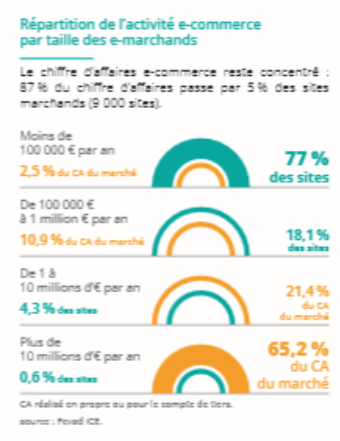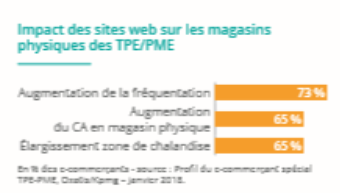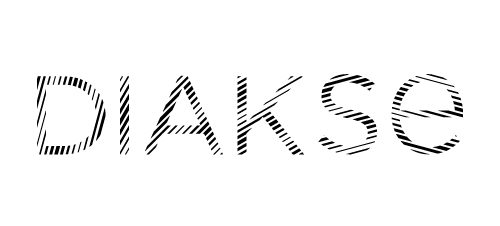E-commerce is booming...

For some years now, we've been lamenting growth rates that no one has been able to get off the ground, and we're ecstatic when they increase by a tenth. The same certainly cannot be said of e-commerce. The sector continues to boom, despite sluggish economic growth.
57 billion in sales in 2014. 65 in 2015. 72 in 2016. 81.7 in 2017. Growth rates of 13% are unheard of. Rare are the sectors where investment is so high: on average, the number of e-commerce sites is growing by 10% a year. Retailers are saying to themselves: 37.5 million French people buy on the Internet, that's 37.5 million potential customers, not to mention the fact that this figure increases every year. People are buying more on the internet, more and more often: I absolutely have to be there. It's time for the digital transition.
But its boom is a boom for many.

Here's the thing: we often don't know all the figures. Every year, FEVAD, the professional organization representing e-commerce players, publishes a map of e-commerce. The report is very clear: yes, e-commerce does make money, and a lot of it. Today, it accounts for 8.5% of retail sales. But its profits are increasingly concentrated in the context of tougher and tougher competition.

A closer look reveals that sales are essentially in the hands of a few e-commerce “monsters”, in order: Amazon, Cdiscount, Fnac, Vente Privée, OUI SNCF. In fact, 0.6% of sites concentrate some 65.2% of the market. And 77% of sites are left with 2.5%.
Who are these 77%? Well, sites created by retailers wishing to start a business on the Internet, who (rightly) see their website as an extension of their physical store that can increase their sales, but often underestimate the significant (very significant) costs involved in creating such a site: creation costs, customer acquisition, logistics, purchasing, after-sales service.
The problem is this: when you're on the Internet, you can't bring yourself to leave. Even if we don't generate enough traffic to be profitable, we still want to keep our site, if only because it plays an essential role in the customer journey: 78% of customers find out more about a brand's website before buying one of its products. As a result of this stubbornness, lack of investment and insufficient optimization, 35% of the websites of small and medium-sized businesses are loss-making.
We certainly wouldn't say that going online isn't a good idea. On the contrary, but until now the only consolation for “small merchants” has been to focus on a web-to-store strategy that sometimes pays off (again according to FEVAD, 73% of small and medium-sized businesses saw an increase in footfall in their physical stores after setting up their website). But setting up an e-commerce site is not the same as trying to increase sales in a borderless market, by only allowing the customer to see the same product sheet over and over again... Amazon and co. will always be better at this! So we need to reinvent online shopping, and enable visitors to understand the brand's universe and personality; to develop interactivity with them; to gather data to optimize sales strategy, which, by the way, is what the Diakse solution does so well.

So you have to go online. But you have to go there to make a profit. That's why Diakse was created.
How can an e-commerce site that isn't one of today's “behemoths” stand out from the crowd?
Here's what we've found. What enhances the value of an e-commerce site, increases traffic, visitor time and therefore, logically, sales, is its ability to be personalized, to adapt to each user by offering a truly personalized shopping experience. It's the simplicity of its interface, which interacts with the visitor, immersing him or her in a sales environment. It's its ability to put products into context, and so assert itself as a force of proposition to transform the visitor into a customer (see, for example, Leroy Merlin, which creates interiors to encourage customers to make more purchases).
It's important to understand that people go to e-commerce sites for two reasons. First, they want something very specific. In that case, they'll spend two minutes on Vente Privée.com and find what they're looking for. Second: they don't know what they want. This is where everyone who isn't a “monster” comes in. To convince the prospect, they need to reproduce the same path as in the store, take care of the aesthetics of their site, and explain the exclusivity of your products in the same way. They need to be pragmatic and attentive, but above all they need to assert their personality. It's all about making 2 worlds coexist, in the same way that shopping malls coexist with city-center boutiques. The only way to do this is to create a unique shopping experience linked to the brand's universe. For independent merchants, fighting on the Internet with the same tools as the leaders is futile: the latter will always master them faster, and with a scale factor in their favor.
It's clear: if your strategy isn't mass-market, but one of differentiation and personalized experience, if your product is unique and your offer high-end, it's in your interest to develop discriminating tools so as not to be just another e-commerce site. Diakse offers one such tool.
